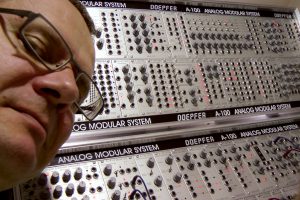The first edition of the (German only) “Big Book on the A-100” arose from my own need to summarize everything worth knowing about my newly acquired modular system. Contrary to all trends and recommendations, I put together a “monoculture” system exclusively with modules from Doepfer and – also against all advice – equipped it with a comparatively large number of modules right from the start.
So there it was – at the beginning of 2010 – the precious stuff and it was exactly what I had wished for. I was able to derive many things with a little basic knowledge of synthesizers and get started right away: What does a VCO do, what does a VCA, VCF etc. But for some modules there was “special knowledge”, such as jumper positions, special possible uses, but also limits such as suitability for audio and / or slow modulation signals, as well as small errors in certain production series of individual modules that had to be taken into account. A comprehensive manual to look it all up would have been nice! At that time there was already a lot of information about the A-100, but unfortunately scattered from different sources and with very different orientation, quality and demands on the inclined reader.
Well, a book then. Does anyone else need this besides me? Will a publisher print this? Is all the effort worth it? It quickly became clear that the “target group” existed, but that the book would still be a long way from being a bestseller. In other words, a micro-publisher of its own, spreadsheets with printing costs, end-consumer prices, dealer margins, taxes, etc. followed. Nevertheless, it is of no use to produce 20,000 books at a very low price if the fan base unfortunately only buys 500 copies.
At the end of 2011 the time had come, the first edition was printed, delivered on a Euro pallet weighing several hundred kilograms and finally stored in the basement of my Munich apartment at the time.
The project would certainly not have been a success without the support of third parties. First and foremost Dieter Döpfer, who always had an open ear for my questions, but also the music dealers, who then included the book in their program: Hieber Lindberg in Munich, the Doepfer company itself, of course, Schneiders Laden in Berlin, Stromraum in Stuttgart, Synmag Verlag in Rellingen, Just Music in Berlin and a few more. Thank you, I hope you enjoyed it as much as I did!
Today, this first edition has long since been completely sold, some of the modules described had to be taken out of the program due to a lack of components that had become rare (Curtis chips!) in order to be reissued a few years later with replicas of these chips – and an incredible number of new modules have been added. Reason enough to think about a new edition.
The outline gave me the most headache. For example, I wanted to continue to show the complexity of most modules – a sequencer can also play oscillator, a delay can do that too, but even a “primitive” switch or a morphing generator can do amazing things with simple waveforms. The new modules from Doepfer underline this complexity even further (thru-zero oscillators or polyphony, nuff said!)
In the first edition, I tried to show this complexity with several sections per module: one entry in the chapter about the oscillators, another for the sequencers, etc. Ultimately, however, this reaches its limits and becomes a bit confusing. At some point even very confusing. In addition, I wanted to create the new edition in a modular way – according to the subject – so that new modules can easily be integrated into the previous “work” in the future. With multiple entries for each module, something like this is hardly possible anymore. The original book already had a lot of cross-references, because one module was always interesting in the context of another module. In printed form, this has clear limits, too many cross-references quickly become confusing because you always have to scroll back and forth.
On this website I distinguish between “chapters” (pages) and “posts”. This is actually a type of outline that comes from WordPress, the content management system used here, but I actually find it quite appropriate for my purposes.
“Chapters” are overview articles that cover an entire subject area and contain some background information. So far there are 9 such “chapters”:
Chapter 1: From a book to a website and why
Chapter 3: Generating tones and noise
Chapter 4: Filter without coffee?
Chapter 5: Other sound shapers
Chapter 6: Mix, Amplify, Distribute
Chapter 7: Modulators – sounds are moved
Chapter 8: Strange but useful modules
Chapter 9: Polyphony in the A-100
For each module there is a separate “post” that describes the module in detail. These contributions to the modules are linked accordingly in the above-mentioned chapters. Otherwise, the now more than 140 posts may be a bit overwhelming, so that each module is assigned to one or more categories (e.g. “oscillator”, “frequency divider”, “mixer”, “envelope generator” etc.) to make it easier to find the description needed. An overview of all previously published contributions can be found here: Modules by categories.
In addition, there are keywords “TAGs” for each entry, which refer to special features of the module, such as “currentless modules”, “sound samples”, the new “Slim Line” design, etc. Here you can use the “TAG Cloud” to search for specific properties:
ADSR (1) AS3320 (1) AS3394 (1) BBD (1) Breakout (1) Buchla (2) CEM3320 (3) CEM3340 (3) CEM3360 (1) CEM3394 (1) Currentless modules (1) Curtis (8) Digital (3) EMS (1) ERWIK (1) Filter (25) Karplus Strong (1) Korg (1) LFO (2) LPG (1) Midi (4) Moog (2) MS-20 (1) Noise (4) not described in my book (35) Oberheim (3) Out of production (15) Phaser (1) Polyphonic (6) Quadrature (3) Random generator (4) Ring Modulator (2) Running out (2) SEM (1) Slim line (13) Sound examples (61) Source of Uncertainty (1) SSM (2) SSM2044 (2) SSM2164 (1) Steiner-Parker (1) TB-303 (1) Thru Zero (2) Transistor Ladder (2) Trautonium (3) Vactrol / opto FET (4) VCA (2) VCO (11) Vocoder (4) Wasp (1) Xpander (2)
So restart. All the previous information – and lots of new stuff – has been transferred to the website you see in front of you. Instead of a book that is long outdated, you now have access to a dynamically growing medium.
This leaves me with the hope that the inclined reader will think at this point: “Oh, that’s practical!”
Hohenlinden, October 2017 (German edition), January 2022 (English edition)
Andreas Krebs
Next chapter:

